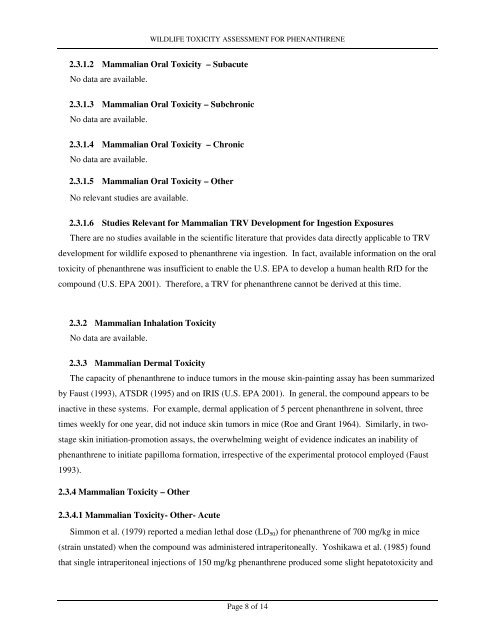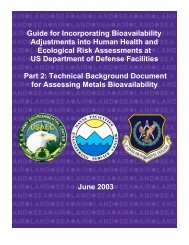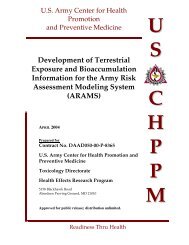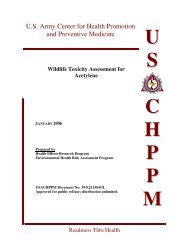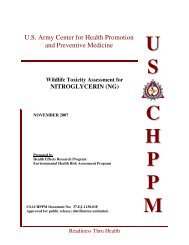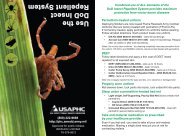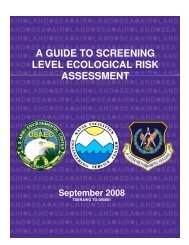WILDLIFE TOXICITY ASSESSMENT FOR PHENANTHRENE2.3.1.2 Mammalian Oral Toxicity – SubacuteNo data are available.2.3.1.3 Mammalian Oral Toxicity – SubchronicNo data are available.2.3.1.4 Mammalian Oral Toxicity – ChronicNo data are available.2.3.1.5 Mammalian Oral Toxicity – OtherNo relevant studies are available.2.3.1.6 Studies Relevant for Mammalian TRV Development for Ingestion ExposuresThere are no studies available in the scientific literature that provides data directly applicable to TRVdevelopment for wildlife exposed to phenanthrene via ingestion. In fact, available information on the oraltoxicity of phenanthrene was insufficient to enable the U.S. EPA to develop a human health RfD for thecompound (U.S. EPA 2001). Therefore, a TRV for phenanthrene cannot be derived at this time.2.3.2 Mammalian Inhalation ToxicityNo data are available.2.3.3 Mammalian Dermal ToxicityThe capacity of phenanthrene to induce tumors in the mouse skin-painting assay has been summarizedby Faust (1993), ATSDR (1995) and on IRIS (U.S. EPA 2001). In general, the compound appears to beinactive in these systems. For example, dermal application of 5 percent phenanthrene in solvent, threetimes weekly for one year, did not induce skin tumors in mice (Roe and Grant 1964). Similarly, in twostageskin initiation-promotion assays, the overwhelming weight of evidence indicates an inability ofphenanthrene to initiate papilloma formation, irrespective of the experimental protocol employed (Faust1993).2.3.4 Mammalian Toxicity – Other2.3.4.1 Mammalian Toxicity- Other- AcuteSimmon et al. (1979) reported a median lethal dose (LD 50 ) for phenanthrene of 700 mg/kg in mice(strain unstated) when the compound was administered intraperitoneally. Yoshikawa et al. (1985) foundthat single intraperitoneal injections of 150 mg/kg phenanthrene produced some slight hepatotoxicity andPage 8 of 14
WILDLIFE TOXICITY ASSESSMENT FOR PHENANTHRENEeffects on blood chemistry in rats. Though not applicable to derivation of a TRV, these studies stillprovide toxicity information bearing on the potential effects to wildlife.2.3.4.2 Mammalian Toxicity-Other- SubacuteIn one of the few published experiments to explore the toxicological effects of phenanthrene, thecompound was administered to male Holtzman and Charles River rats (12 animals/group) for 7 days viaintraperitoneal injection (0.35 mg/rat/day) (Gershbein 1975). Rats were terminated three days later atwhich point the body weights and excised liver weights were recorded and compared to those of untreatedcontrols. The near identity in group-specific body weights and the close similarity between the liverweights of test versus control animals indicated that phenanthrene had little toxic impact on the subjects atthe administered dose. The use of this dose (approximately 1.38 mg/kg-day) as a No-Observed-Adverse-Effects-Level (NOAEL) is complicated, and of extremely low confidence, since no toxic effects ofphenanthrene have been defined in this or any other study. Furthermore the use of a single dose levelprecludes the delineation of the compound's toxicological threshold.2.3.5. Studies Relevant for Mammalian TRV DevelopmentIn the single study that was identified as potentially relevant to TRV development, the absence of anytoxicological consequences of phenanthrene administration in rats at the only dose tested did not allow adependable Low-Observed-Adverse-Effect-Level (LOAEL) or No-Observed-Adverse-Effect-Level(NOAEL) to be identified (Gershbein 1975). Physiological experiments by Rahman et al. (1986) suggestthat phenanthrene's inactivity is probably not related to failure to penetrate the intestinal mucosa where, atleast in male Sprague-Dawley rats, the compound appeared to be more or less quantitatively absorbed.The use of other protocols has pointed to the largely benign nature of phenanthrene in experimentalsystems. Thus, the compound appears to be negative in the Ames test, even in circumstances where itsreactive metabolite, phenanthrene 9,10 oxide, itself brings about gene reversion in Salmonellatyphimurium strains TA98, TA100, TA1537 and TA1538 (Bucker et al. 1979). However, when Bucker etal. (1979) included the epoxide hydratase inhibitor, 1,1,1-trichloropropene 2,3-oxide in the culturemedium, they observed the formation of histidine-independent colonies, which suggests thatphenanthrene is normally inactive in this system because its active metabolite normally cannotaccumulate. More recent studies have shown phenanthrene to be weakly positive in TA100, butineffective in TA98 (Bos et al. 1988).In the battery of experiments aimed at researching the ability of PAHs to induce or initiate skin tumorsin mice, phenanthrene has been found to be inactive under most experimental conditions and does notbehave like a complete carcinogen (Faust et al. 1993; ATSDR 1995).Page 9 of 14


